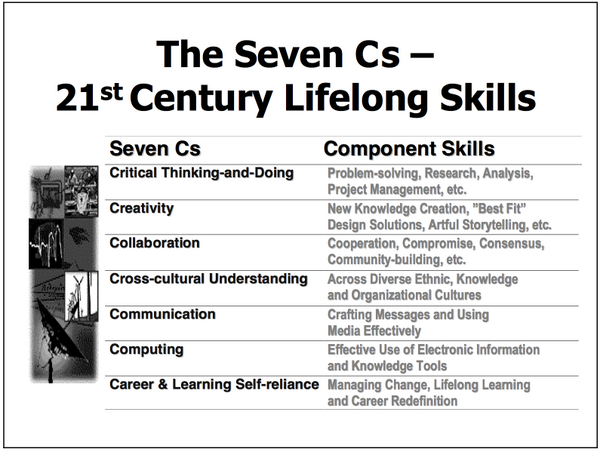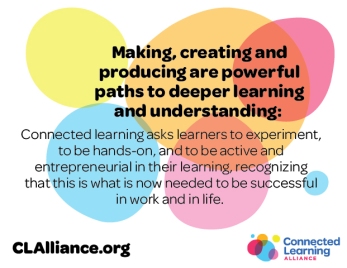Why should educators be connecting their students globally?
What literature, research and opinions can you gather and synthesise to support an argument for this?
Authored by Jessica Heysen, Rajashree Basu, and Jolanta Stephens
It is fair to say that the educators of 2015 and beyond are tasked with a very different job description than those of even 10 years ago. As the world we live in evolves at a rate that is challenging to stay in touch with, it is critical that our education system and what we are teaching our children does the same. No longer is it enough to be disseminators of information, using “chalk and talk” as the medium to which we educate our students. No longer is it enough to teach our students to read and write and learn arithmetic. The students of today will be graduating into a vastly different world, they will be entering a global society which requires them to be “proficient communicators, creators, critical thinkers, and collaborators” (National Education Association 2015). Our students need to be armed with the skills to manage a work life balance in a world where everyone is connected 24/7.
Life today is exponentially more complicated and complex than it was 50 years ago. This is true for civic life as much as it is for work life. In the 21st century, citizenship requires levels of information and technological literacy that go far beyond the basic knowledge that was sufficient in the past. With a host of challenges facing our communities, along with instant connectivity to a global society, civic literacy couldn’t be more relevant or applicable to the curricula in our schools… The rapid decline in “routine” work has been well documented by many researchers and organizations. At the same time, there has been a rapid increase in jobs involving nonroutine, analytic, and interactive communication skills. Today’s job market requires competencies such as critical thinking and the ability to interact with people from many linguistic and cultural backgrounds (cultural competency).
(National Education Association 2015)
Let us first scaffold the meaning of connected learning
(Ito et al.) defines connected learning as “ broadened access to learning that is socially embedded, interest-driven, and oriented toward educational, economic, or political opportunity. Connected learning is realized when a young person is able to pursue a personal interest or passion with the support of friends and caring adults, and is in turn able to link this learning and interest to academic achievement, career success or civic engagement.”
Let us look at some of the learning theories and compare this learning theory behind the connected learning model
Behaviorism, cognitivism, and constructivism are the three broad learning theories most often utilized in the creation of instructional environments. These theories, however, were developed in a time when learning was not impacted through technology. Over the last twenty years, technology has reorganized how we live, how we communicate, and how we learn. Learning needs and theories that describe learning principles and processes, should be reflective of underlying social environments. Vaill emphasizes that
“learning must be a way of being – an ongoing set of attitudes and actions by individuals and groups that they employ to try to keep abreast the surprising, novel, messy, obtrusive, recurring events…”
(1996, p.42).

Connectivism is the integration of principles explored by chaos, network, and complexity and self-organization theories. Learning is a process that occurs within nebulous environments of shifting core elements – not entirely under the control of the individual. Learning (defined as actionable knowledge) can reside outside of ourselves (within an organization or a database), is focused on connecting specialized information sets, and the connections that enable us to learn more are more important than our current state of knowing.
Let us share with you this infographic we found:
 (Britt, 2001)
(Britt, 2001)
If we take a look at this infographic, what are your initial thoughts about the way technology is going?
Every minute millions of people are using the internet and digital technology in some way – some for personal use, some for work, some for connecting with others. In a 21st Century, we need to be teaching our students how to globally connect and the skills associated with these. We are living in an ever increasing digital and globally connected world, and our students need to be literate members of it.
Digital Literacy as part of 21st Century Skills
Our students are going to be the programmers and policy writers of the future, they will be the people who are trying to solve some of the world’s most complicated problems such as global warming, the refugee crisis, financial meltdowns and dealing with an exponentially growing technological world. But no longer can the people of one country tackle these tasks alone.
“The world faces global challenges, which require global solutions. These interconnected global challenges call for far-reaching changes in how we think and act for the dignity of fellow human beings.”
“It is not enough for education to produce individuals who can read, write and count.”
“Education must be transformative and bring shared values to life. It must cultivate an active care for the world and for those with whom we share it. Education must also be relevant in answering the big questions of the day.”
“Technological solutions, political regulation or financial instruments alone cannot achieve sustainable development. It requires transforming the way people think and act.”
“Education must fully assume its central role in helping people to forge more just, peaceful, tolerant and inclusive societies. It must give people the understanding, skills and values they need to cooperate in resolving the interconnected challenges of the 21st century.”
(United World Schools 2015)
However in order to prepare our students for the life that lay ahead of them, we need to acknowledge the needs of a 21st Century Learner. We need to ensure they are self-directed learners, globally aware, communicators, problem solvers, critical and creative thinkers, civically engaged, collaborators, information and media literate, financially and economically literate and innovative.
“Advocates of 21st century skills favor student-centered methods—for example, problem-based learning and project-based learning—that allow students to collaborate, work on authentic problems, and engage with the community”
(Rotherham and Willingham, 2009).
As educators we need to be providing our students with opportunities to participate in well designed and planned collaborative learning experiences, not just within the four walls of our classrooms but globally.
“Doing so engages students, furthers their learning, improves intercultural awareness, and connects them to the contributions of diverse and valued cultures… The potential power of combined talents between nations could greatly improve the amount of knowledge and possible solutions to these global problems.”
(Why international collaboration?, 2009)

(EdTech, 2015)
As we can see from this table from Fishtree EdTech, the skills required by a 21st Century member of society link to being globally connecting. In particular, it is essential for members of a 21st Century society and workforce to have a cross-cultural understanding and be able to effectively communicate, not just with people in their direct community, but with all others involved – whether it be within the company, or internationally. Collaboration needs to extend beyond ‘group work’ in the classroom, and start making authentic connections with real-life situations, that is, collaboration with students, teachers and information from around the world.
Globally Connecting – Why we should do it
Connectivism presents a model of learning that acknowledges the tectonic shifts in society where learning is no longer an internal, individualistic activity. How people work and function is altered when new tools are utilized. The field of education has been slow to recognize both the impact of new learning tools and the environmental changes in what it means to learn. Connectivism provides insight into learning skills and tasks needed for learners to flourish in a digital era.(Siemens)
Furthermore, globally connecting provides exciting opportunity for students, especially when teamed with Project-based Learning (PBL). It gives students an opportunity to practice these essential 21st Century learning skills, but also engage with other ‘real people’ and sources – and form emotionally engaging and authentic connections to what they are learning.
What are the outcomes of connected learning?
This reference to the existing educational model which gives less access to learning is the key reason why we as educators should connect our students globally.Connected learning focuses attention on the spaces of integration and translation between divergent domains of knowledge, culture, and social practice.Connected learning is oriented to outcomes that are both individual and collective in nature. These include 21st Century skills, dispositions, and literacies such as systems thinking, information literacy, creativity, adaptability, conscientiousness, persistence, global awareness and self-regulation as well as the cultivation of interests, building of social capital, and a positive orientation to academic subjects. Because the connected learning model takes an ecological and networked approach, these individual outcomes are tied to societal outcomes that are collective in nature. These include building high quality forms of culture and knowledge, civically activated collectives, and diverse pathways for learning and recognition. In this way, the support and cultivation of individual capacity is part and parcel of a broader vision of an educational system that is vastly more effective, equitable and essential.
Final Thoughts…
Times are changing.

It’s in our faces the whole time, media, social media, the internet, new technological advances… the world is not the same place it was 5, 10, 15 years ago. It is no longer enough to teach students the content from a text book and to tick off a checklist of outcomes. We, as educators, must provide our students with the best opportunities and prepare them to be the best members of society that they can be. And when society is becoming increasingly ‘global’, we need to prepare them with all the tools we have to fight and succeed in their fields of life.


